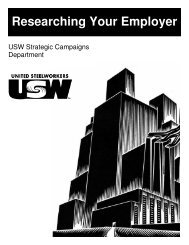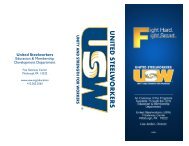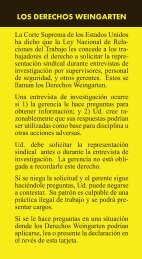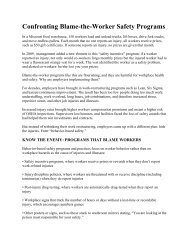Union Approach to Health and Safety: - United Steelworkers
Union Approach to Health and Safety: - United Steelworkers
Union Approach to Health and Safety: - United Steelworkers
You also want an ePaper? Increase the reach of your titles
YUMPU automatically turns print PDFs into web optimized ePapers that Google loves.
902 DECISIONS OF THE NATIONAL LABOR RELATIONS BOARD<br />
9 See 309 NLRB at 994 fn. 20 (Devaney, concurring).<br />
<strong>to</strong> work on <strong>and</strong>, if possible, <strong>to</strong> solve, management-designated<br />
problems, but retains the flexibility <strong>to</strong> dissolve<br />
the committee when its effectiveness has ended, <strong>to</strong><br />
start it or another up when needed again, <strong>to</strong> set its<br />
agenda, <strong>and</strong> <strong>to</strong> include managers <strong>and</strong> supervisors on it<br />
if these fac<strong>to</strong>rs would increase the committee’s effectiveness.<br />
Further, the success of many types of employee involvement<br />
programs depends on persuading employees—or<br />
freeing them—<strong>to</strong> turn their full attention <strong>and</strong><br />
intelligence <strong>to</strong> the solution of management problems;<br />
<strong>to</strong> forget, in a sense, for the duration of the committee’s<br />
work that they have their own separate interests<br />
in the workplace <strong>and</strong> <strong>to</strong> do the employer’s work. Employers<br />
‘‘dominate’’ employees every time a supervisor<br />
or manager issues work instructions <strong>to</strong> statu<strong>to</strong>ry<br />
employees; employers ‘‘dominate’’ groups of employees<br />
every time a group is instructed <strong>to</strong> perform a task.<br />
Without more, I see no unlawful behavior or threat<br />
<strong>to</strong> employees’ Section 7 rights when employers form<br />
employee committees with management members, provide<br />
such committees with funds, time, space, <strong>and</strong><br />
compensation, assign the committees agendas, <strong>and</strong> dissolve<br />
them at will. Such committees need not interfere<br />
with the employees’ exclusive right <strong>to</strong> choose a representative—if<br />
they do not pretend <strong>to</strong> represent the interests<br />
of employees as distinct from those of the employer.<br />
Under the statute, an employer violates Section<br />
8(a)(2) by ‘‘dominating’’ only one of the many types<br />
of employee groupings or committees that employers<br />
have found valuable: a labor organization dealing with<br />
the employer with respect <strong>to</strong> conditions of employment.<br />
In my view, the crucial issue in every case<br />
where an employee committee is alleged <strong>to</strong> violate<br />
Section 8(a)(2) is whether the employer has usurped<br />
the exclusive right of the employees <strong>to</strong> choose their<br />
own representative <strong>to</strong> deal with the employer with respect<br />
<strong>to</strong> conditions of work. As I noted in<br />
Electromation, 9 I would interpret evidence that an employer<br />
represented a dominated committee <strong>to</strong> employees<br />
as its exclusive agent <strong>and</strong> made it clear that employees<br />
who served on it did so <strong>to</strong> further the employer’s<br />
managerial goals as indications that the committee<br />
in question was not a labor organization dealing with<br />
the employer over conditions of employment.<br />
I find the contrast between the operation of the six<br />
safety committees <strong>and</strong> the ‘‘safety conferences’’ <strong>and</strong><br />
‘‘safety pauses’’ instructive. The latter two types of<br />
meetings were, like the seven committees discussed<br />
above, structured according <strong>to</strong> the PEP principles <strong>and</strong><br />
employees were divided in<strong>to</strong> small groups <strong>to</strong> work on<br />
specific <strong>to</strong>pics relating <strong>to</strong> safety. The employees were<br />
informed that bargainable issues could not be discussed,<br />
<strong>and</strong> when bargainable issues arose, they were<br />
placed on a ‘‘bucket list’’ <strong>and</strong> were not discussed during<br />
the meetings. I see little distinction, with respect<br />
<strong>to</strong> the issue of employer domination, between the safety<br />
committees discussed above <strong>and</strong> the safety conferences<br />
here. In all cases, the Respondent created the<br />
employee groups <strong>and</strong> included supervisors in them.<br />
The safety conferences <strong>and</strong> pauses are, however, quite<br />
different from the safety committees in a crucial respect:<br />
the Respondent did not establish the safety conferences<br />
<strong>and</strong> pauses as representatives of the employees<br />
<strong>and</strong> did not bargain or ‘‘deal with’’ them over<br />
m<strong>and</strong>a<strong>to</strong>ry subjects of bargaining; in fact, the Respondent<br />
<strong>to</strong>ok pains <strong>to</strong> inform the employees who participated<br />
that the conferences were not a substitute for<br />
union representation <strong>and</strong> that bargainable issues could<br />
not be discussed. Thus, the status of the safety conference<br />
<strong>and</strong> pauses remained clear: they were managerial<br />
<strong>to</strong>ols for solving managerial problems, <strong>and</strong> there<br />
was no effort <strong>to</strong> make them appear <strong>to</strong> be acting on behalf<br />
of the employees. Here the Respondent made the<br />
right choices. It used ‘‘employee committees’’—the<br />
safety conferences <strong>and</strong> pauses—that were management<br />
<strong>to</strong>ols as management <strong>to</strong>ols, without tacitly according<br />
them the status of bargaining agents in their areas of<br />
concern. Thus, there was no usurpation of the employees’<br />
exclusive right <strong>to</strong> designate their own representative.<br />
4. Did the Respondent ‘‘deal with’’ the dominated<br />
employee committees over m<strong>and</strong>a<strong>to</strong>ry subjects<br />
of bargaining?<br />
In my view, it is unnecessary <strong>to</strong> reach the question<br />
whether DuPont ‘‘dealt with’’ the dominated committees,<br />
inasmuch as the record clearly demonstrates that<br />
the Respondent bargained with those entities. 10 As the<br />
10 I am uncomfortable with the majority’s discussion of the meaning<br />
of ‘‘dealing with,’’ especially here, where the higher level of involvement,<br />
bargaining, is so clearly present. In my view, bargaining<br />
is a bilateral process, but ‘‘dealing with’’ is not necessarily bilateral,<br />
as employers can use an ostensibly bilateral process as a strictly unilateral<br />
one by appearing <strong>to</strong> consider employee proposals without actually<br />
considering them. I agree that a ‘‘suggestion box,’’ in which<br />
employees acting as individuals, with or without managers, come up<br />
with a range of suggestions <strong>and</strong> recommendations for management<br />
<strong>to</strong> consider would not be bargaining or ‘‘dealing with.’’ Similarly,<br />
a brains<strong>to</strong>rming group of employees who work <strong>to</strong>gether, with or<br />
without managers, <strong>to</strong> come up with suggestions <strong>and</strong> recommendations<br />
for management, is not ‘‘dealing with.’’ In both situations, bargaining<br />
or ‘‘dealing with’’ is not present in part because the employees<br />
have no expectation other than that management will consider<br />
their suggestions <strong>and</strong> they underst<strong>and</strong> that they are acting on management’s<br />
behalf in participating. But I disagree with the majority<br />
when it characterizes a proposal <strong>and</strong> its immediate acceptance as not<br />
constituting bargaining. In my view, that two-step process can indeed<br />
constitute bargaining, <strong>and</strong> under some circumstances some<br />
might say it is bargaining at its most successful <strong>and</strong> efficient.<br />
Rather than attempting <strong>to</strong> outline the differences between ‘‘dealing<br />
with’’ <strong>and</strong> ‘‘bargaining’’ in the abstract, I find it instructive <strong>to</strong> return<br />
<strong>to</strong> the legislative his<strong>to</strong>ry. After hearing the testimony of witnesses<br />
in the 1934 <strong>and</strong> 1935 Wagner Act hearings before the Senate Labor<br />
<strong>and</strong> Education Committee that the ‘‘bargaining’’ going on between














